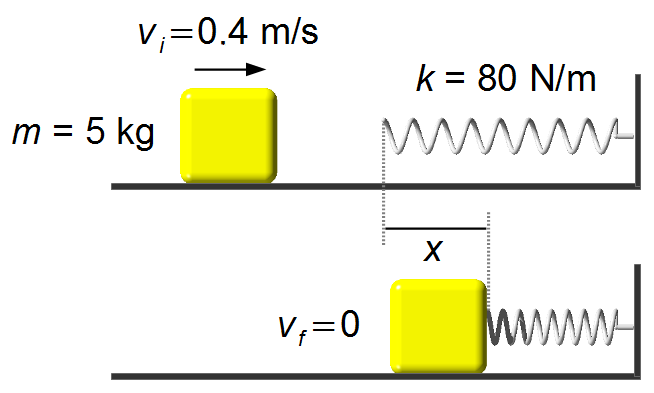Solved Problem on Work and Energy
advertisement
A block with a mass equal to 5 kg is released with a constant speed of 0.4 m/s and shocks with a spring of elastic constant 80 N/m, and the surface is frictionless. Determine the maximum compression of the spring.
Problem data:
- Mass of block: m = 5 kg;
- Initial speed of block: vi = 0.4 m/s;
- Spring constant: k = 80 N/m.
Initially, the block has kinetic energy,
\( K^{block} \),
due to its speed. As the problem gives the surface is frictionless, and there are no dissipative
forces acting in the system, then when the spring has the maximum compression, the speed of the block
is zero, and all the kinetic energy of the block is transferred to the spring as elastic potential
energy,
\( U_{s}^{spring} \).

Solution
The kinetic energy of the block is given by
\[
\begin{gather}
\bbox[#99CCFF,10px]
{K=\frac{mv^2}{2}}
\end{gather}
\]
The elastic potential energy is given by
\[
\begin{gather}
\bbox[#99CCFF,10px]
{U_s=\frac{kx^2}{2}}
\end{gather}
\]
Applying the condition, the kinetic energy of the block and the elastic potential energy of the
spring must be equal
\[
\begin{gather}
K^{block}=U_{s}^{spring}\\[5pt]
\frac{mv_i^2}{\cancel 2}=\frac{kx^2}{\cancel 2}\\[5pt]
mv_i^2=kx^2\\[5pt]
x^2=\frac{mv_i^2}{k}\\[5pt]
x=\sqrt{\frac{mv_i^2\;}{k}}\\[5pt]
x=\sqrt{\frac{(5\;\mathrm{kg})\times(0.4\;\mathrm{\frac{m}{s}})^{2}\;}{80\;\mathrm{\frac{N}{m}}}}\\[5pt]
x=1\times 10^{-1}\;\mathrm m
\end{gather}
\]
\[ \bbox[#FFCCCC,10px]
{x=0.1\;\mathrm m}
\]
advertisement

Fisicaexe - Physics Solved Problems by Elcio Brandani Mondadori is licensed under a Creative Commons Attribution-NonCommercial-ShareAlike 4.0 International License .